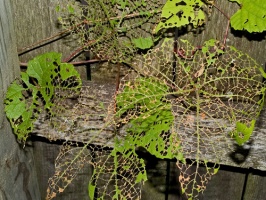
Skeletonized leaves by Joe Rudd
Japanese beetles can do quite a bit of damage to the foliage of a tree in short time because they swarm and the damage is multiplied by their great numbers.
They usually start eating at the top of the tree and then work their way down from there. The beetles eat only the flesh of the leaves and the veins are all that remain when they are through.
Sometimes Japanese beetles eat small holes in the leaves rather than consuming all of the flesh, especially if it is not a large group. The damage can be so extensive that it appears as if the foliage of the tree has been burned.
For flowers like roses and the like, Japanese beetles will eat the buds of the plant and leave the stems alone. The petals of the flower will be chewed through and have holes in them. This can be quite a frightening and shocking sight to a gardener who has put in plenty of work in his craft.
If the damage to the leaves is extensive enough, it may prevent the tree from being able to convert sunlight into biological energy. This potentially makes the tree vulnerable to parasites and disease. It is not uncommon for trees to die after being eaten by a Japanese beetles.
The way Japanese beetles eat leaves is sometimes referred to as skeletonizing because all that is left is the skeleton of the leaves.

Leave a Comment